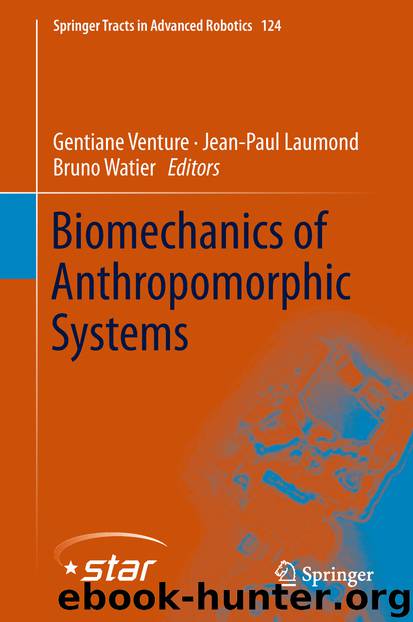Biomechanics of Anthropomorphic Systems by Unknown

Author:Unknown
Language: eng
Format: epub
ISBN: 9783319938707
Publisher: Springer International Publishing
2 Modeling Task Space Kinematics Using Optimization Principles
2.1 The Minimum Jerk Model Defining the Smoothest Trajectory
The optimality of movement based on the minimum jerk model states that a trajectory is optimal in the sense that the cumulative squared jerk, i.e., the squared jerk cost integrated over the entire movement duration, is minimal:
The minimum jerk model enables to predict how the motor system operates under different task requirements such as the generation of point-to-point reaching or obstacle-avoidance movements [19, 23].
For point-to-point movements, given some boundary conditions, the two-dimensional trajectory predicted by this jerk minimization model is such that and are fifth order time polynomials. In the simplest case of zero speed and acceleration at the movement start-point and end-point, the resulting trajectories are straight paths with symmetric bell-shaped velocity profiles, closely resembling stereotypical human behavior.
To model curved trajectories, the movements were assumed to start at some initial point, pass through one or several additional intermediate points (termed via-points), and end at some specified end-point. For example, using the minimum jerk model, the optimization process predicts the movement that should be generated between the initial and final positions while passing through each via-point along the way at an a priori unspecified time. The solution of this minimization problem defines the movement between each pair of consecutive points as a 5th order time-dependent polynomial, with equality position constraints obeyed by the movement segments on both sides of each via-point. The model predicts the path geometry and full kinematic profile including internal timing.
For various applications, it is sometimes more helpful to examine the jerk cost after some normalization. For instance, if we assume a movement duration T and an amplitude S to be specified, then a normalized version, the unit-less normalized jerk, can be defined as which makes it easier to compare and examine the jerk costs across different movement shapes. Other approaches to normalize the jerk cost were based, for example, on the spectral arc-length metric [3].
For a given path, path-constrained optimization deals with the problem of finding the optimal speed profile along the prescribed path [51, 56]. The predicted speed profile, the solution of the path-constrained optimization problem, is specifying the dependency of the end-effector speed on the path shape (geometry).
The relations between the predictions arising from optimization and those resulting from equi-affine invariance, which we discuss next, were examined from different perspectives [24, 27, 39, 49, 51, 60]. It is interesting to mention that the equi-affine parametrization (i.e. the two-thirds power law) corresponds to the case where the jerk vector is proportional to the velocity vector . Possible extensions of the minimum jerk model naturally arise if one examines the time derivatives of some order k being different from which relates to the time derivative of position, i.e., jerk used in the minimum jerk model. The minimum acceleration model, with was also used to model human behavior during reaching tasks [4]. The minimum acceleration cost also appears to be a good candidate for describing human locomotion [41]. The minimum snap model
Download
This site does not store any files on its server. We only index and link to content provided by other sites. Please contact the content providers to delete copyright contents if any and email us, we'll remove relevant links or contents immediately.
Algorithms of the Intelligent Web by Haralambos Marmanis;Dmitry Babenko(8310)
Test-Driven Development with Java by Alan Mellor(6807)
Data Augmentation with Python by Duc Haba(6722)
Principles of Data Fabric by Sonia Mezzetta(6468)
Learn Blender Simulations the Right Way by Stephen Pearson(6375)
Microservices with Spring Boot 3 and Spring Cloud by Magnus Larsson(6241)
Hadoop in Practice by Alex Holmes(5966)
Jquery UI in Action : Master the concepts Of Jquery UI: A Step By Step Approach by ANMOL GOYAL(5815)
RPA Solution Architect's Handbook by Sachin Sahgal(5642)
Big Data Analysis with Python by Ivan Marin(5402)
The Infinite Retina by Robert Scoble Irena Cronin(5331)
Life 3.0: Being Human in the Age of Artificial Intelligence by Tegmark Max(5160)
Pretrain Vision and Large Language Models in Python by Emily Webber(4367)
Infrastructure as Code for Beginners by Russ McKendrick(4136)
Functional Programming in JavaScript by Mantyla Dan(4044)
The Age of Surveillance Capitalism by Shoshana Zuboff(3964)
WordPress Plugin Development Cookbook by Yannick Lefebvre(3847)
Embracing Microservices Design by Ovais Mehboob Ahmed Khan Nabil Siddiqui and Timothy Oleson(3651)
Applied Machine Learning for Healthcare and Life Sciences Using AWS by Ujjwal Ratan(3628)
